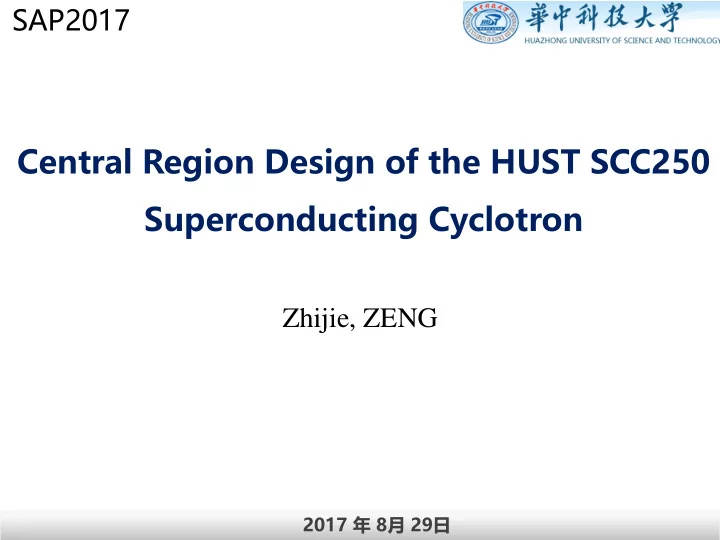

SAP2017 Central Region Design of the HUST SCC250 Superconducting Cyclotron Zhijie, ZENG 2017 年 8 月 29 日
Content 1 、 Introduction 2 、 Central region design 3 、 Beam dynamics 4 、 Conclusions
1 Introduction • Proton therapy has shown advantages in treating several kinds of cancer and has become a favorable treatment option for patients. • At 2016, we decided to develop a superconducting cyclotron based proton therapy facility in the National Key Research and Development Program. • The superconducting cyclotron HUST-SCC250, Advantage: minimizing the size, Difficulty: compact central region.
2 Central region design
2 Central region design PSI SCENT300 • One of the challenging design tasks of a superconducting cyclotrons is the central region. • The initial proton orbits are crucial in determining the properties of the final beam.
2 Central region design • Two main problems : the axial motion and radial motion. Basic parameters Parameters Value DEE width 50 ° DEE DEE voltage 60 kV puller Harmonic mode 2 RF frequency 75.52 MHz chimney Injection radius 1.18 cm Injection angle 122 ° Central magnetic field 2.476 T magnetic pole gap
2.1 Design process 1. Choose a particle state on the AEO. 2. Back tracking to determine the position of the ion source. 3. Forward tracking to optimize the electrode structure. The beam tracking codes Z3CYCLONE and the track command in OPERA are both used in the design process.
2.1 Design process Track command in OPERA
2.1 Design process • the hollow circles marks the maximum energy gain. • the solid circles marks the proton crosses the DEE boundaries. The electrode structure is revised precisely to adjust the RF phase the proton crosses the DEE boundaries.
2.2 Design tips Increase axial Electric focusing • Decrease the gap height • Decrease the gap height only on the entrance side • Place two symmetric pillars on the exit side of the gap Milan
2.3 Electromagnetic distribution The electrode structure in the central region Potential map of the central region The average magnetic field distribution The radial distribution of the vertical focusing tunes
3 Beam dynamics
3.1 Single particle tracking 3.1.1 radial motion Initial state Parameters Value DEE width 50 ° DEE voltage 60 kV Harmonic mode 2 RF frequency 75.52 MHz Injection radius 1.18 cm Injection angle 122 ° Central magnetic field 2.476 T The radial RF phase acceptance is about 20 ° , from 242 ° to 262 ° .
3.1.1 radial motion Theoretical energy gain per turn : maximum energy gain per turn : 0.35MeV , 17.7keV smaller.
3.1.1 radial motion The instantaneous beam curvature center History phase The phase shift range within 30 ° . The deviation less than 1.8cm.
3.1.2 Axial motion z=0, pz=0.0203cm z=0.275cm, pz=0 • Ion source slit half height 0.275cm. • Channel half height 0.45cm ( r<=5cm ) , beam not lost.
3.1.2 Axial motion 0.15 0.1 0.05 2 z 0 n=1 -0.05 n=2 n=3 -0.1 n=4 n=5 -0.15 -50 -40 -30 -20 -10 0 10 20 30 40 50 /[deg] The electric axial focusing force greater for positive phases beam.
3.1.3 Z3CYCLONE vs OPERA Energy gain with Z3CYCLONE cross checked with track command in OPERA. Relative energy gain error less than 1%.
3.2 Multi-particle tracking Initial particle parameters in Gaussian distribution. Parameters 0 . 015 / 3 cm 0 30 / 3 ° 0 0 . 274 / 3 cm z 0 0 . 02 / 3 cm pz 0 252 ° 10 / 3 ° • perpendicular to the ion source establish the local coordinate system. • The and are the x offset and the deflection angle in the local coordinate system respectively.
3.2 Multi-particle tracking The initial particle state. Parameters Gaussian distribution Positon distribution Radial phase space parameters Parameters 0 . 015 / 3 cm 0 30 / 3 ° 0 0 . 274 / 3 cm z 0 0 . 02 / 3 cm pz 0 252 ° 10 / 3 ° Phase distribution Axial phase space
3.2 Multi-particle tracking The beam state after 5 turns. • Most particles energies 1.96MeV. • The radial motion of the positive phase particles is more unstable. Positon distribution Radial phase space • The axial motion of the negative phase particles is more unstable. Energy distribution Axial phase space
4 Conclusions • The compactness of the superconducting cyclotron HUST-SCC250 makes the design difficult. • The central region is optimized iteratively by using several softwares, SOLIDWORKS, OPERA and Z3CYCLONE. • The optimal parameters are as follows, the phase acceptance is about 20 ° , the maximum deviation between the instantaneous beam curvature center and the center of the cyclotron is controlled within 1.8cm.
Thanks for your attention!
Recommend
More recommend